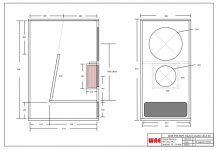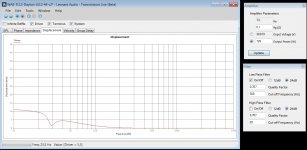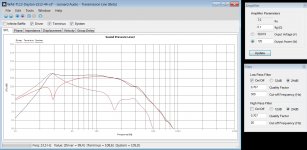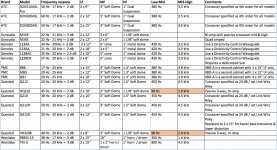Transmission lines are quite forgiving.
Except when it comes to stuffing them 🙂
For bass your limiting factor is likely to be excursion rather than thermal/power.
The two Daytons will 'only' do 110dB/1m at 23Hz before running out of Xmax.
Except when it comes to stuffing them 🙂
For bass your limiting factor is likely to be excursion rather than thermal/power.
The two Daytons will 'only' do 110dB/1m at 23Hz before running out of Xmax.
Last edited:
First PM-DMT design (v2)
Eh Voila, the first (or actually v2) serious version of the TL.
The RED dotted closed box is the closed box for the Coaxial. It's 4,8 liter, we need to subtract the volume taken by the driver, need to figure that out. Most likely, we end up around 2 liter effective closed volume. Roll-off is around 200 Hz for the 8HX200. 😀
As Charles already mentioned, damping is a handful, but hey, never expected this to be a walk in the park 🙂
kind regards.
Note: We opted for 2x LF. It will require a second cabinet, leaving out the closed volume, that's all. Maybe opt for ONE "double TL" enclosure, 2 separate seem more practical.
Eh Voila, the first (or actually v2) serious version of the TL.
The RED dotted closed box is the closed box for the Coaxial. It's 4,8 liter, we need to subtract the volume taken by the driver, need to figure that out. Most likely, we end up around 2 liter effective closed volume. Roll-off is around 200 Hz for the 8HX200. 😀
As Charles already mentioned, damping is a handful, but hey, never expected this to be a walk in the park 🙂
kind regards.
Note: We opted for 2x LF. It will require a second cabinet, leaving out the closed volume, that's all. Maybe opt for ONE "double TL" enclosure, 2 separate seem more practical.
Attachments
Last edited:
Transmission lines are quite forgiving.
Except when it comes to stuffing them 🙂
AHA, was it you that had some practical experience what that topic.... 🙄
For bass your limiting factor is likely to be excursion rather than thermal/power.
The two Daytons will 'only' do 110dB/1m at 23Hz before running out of Xmax.
Did you find this in a correct TL setting?
Leonard software WITH correct filtering predicts, using THIS design, around 6 mm max at 250 watt. That is, IF Leonard software is correct here. THAT's why I liked the TL better than BR, it seems to control the driver better in the low end.
I will post the TL design tomorrow.
The correct filter settings is key.
kind regards.
The 8HX200 takes up 0.8L net according to the spec sheet
The internal volume in this version is 3,2 L The driver = 0,8 L Net volume = 2,4 L which easily supports 200 Hz.
Thanks.
No, nothing so sophisticated, just an online calculator.
I think T/ls like amps which have 'nuff control over them ie active with a high DF amp suits them best IME.
It is probably a good idea to high pass the woofers if things are likely to get loud&low.
I think T/ls like amps which have 'nuff control over them ie active with a high DF amp suits them best IME.
It is probably a good idea to high pass the woofers if things are likely to get loud&low.
I added a high pass @ 20 Hz, not shure if it was 24dB / oct with Q = 0,8. Will check that. Without will kill the driver below the TL tuning freq.
kind regards.
kind regards.
High required
As promised, I would dive into filtering the 12" in the TL yes or no.
The outcome is clear and simple, looks like a must do. Remember we want to use the Hypex, which gives 250 watt at 4 ohm (which is 2 12" drivers.
Resulting in 125 watt per driver, so that's what I used.
I simulated 2 cases;
1 - With a high pass @ 20 Hz, Q = 0,7 and 24 dB / oct
2 - WITHOUT this filter
That's the only change I applied.
See the attachments, the first is WITH high pass, resulting in 5 mm excursion around 23 Hz as a max.. The second shows WITHOUT the high pass, tells it all. We will kill the driver in the end. Reaches 10 mm around 20 Hz, which is it's xlim. Now it may not be likely we have loads of material that require full blown 20 Hz, but we want a solid Studio monitor that can take a beating.
Conclusion: High Pass required.
Also, attachment 3, this is what the SPL influence is WITHOUT the high pass. A rise off 1 dB around the tuning freq of 28 Hz. Nothing spectacular so it's not SPL we need the high pass for.
kind regards.
As promised, I would dive into filtering the 12" in the TL yes or no.
The outcome is clear and simple, looks like a must do. Remember we want to use the Hypex, which gives 250 watt at 4 ohm (which is 2 12" drivers.
Resulting in 125 watt per driver, so that's what I used.
I simulated 2 cases;
1 - With a high pass @ 20 Hz, Q = 0,7 and 24 dB / oct
2 - WITHOUT this filter
That's the only change I applied.
See the attachments, the first is WITH high pass, resulting in 5 mm excursion around 23 Hz as a max.. The second shows WITHOUT the high pass, tells it all. We will kill the driver in the end. Reaches 10 mm around 20 Hz, which is it's xlim. Now it may not be likely we have loads of material that require full blown 20 Hz, but we want a solid Studio monitor that can take a beating.
Conclusion: High Pass required.
Also, attachment 3, this is what the SPL influence is WITHOUT the high pass. A rise off 1 dB around the tuning freq of 28 Hz. Nothing spectacular so it's not SPL we need the high pass for.
kind regards.
Attachments
Wise decision.
If used as a studio monitor at some point somebody WILL drop a live mic so not likely you have loads of material but it will happen.
If used as a studio monitor at some point somebody WILL drop a live mic so not likely you have loads of material but it will happen.
Where to cross the 3-way
OK,
We have decided on a 3-way, one or two LF & a Coaxial, active tri-amped (is that the right word?) using a flexible DSP.
The LF will be a Transmission line preferably and it was commonly agreed to keep the real low's away from the Coax-LF to help it sound at it's best. On the LF, it would be the Dayton L12-44 or the Faital 12PR300 (both simm the same for the TL except for some DSP settings 🙂 ) and the Coaxial will be the Faital 8HX200. That limits the zillion combinations we can choose off. Also looked at BMC driver, some comparable, some to low on efficiency although VERY good and low in price. The Faital 12PR300 is to my direct availability to keep cost in control (some what.. ).
).
Question is, WHERE do we put our crossover points. Now obviously, there are a lot off issues that come into play for this simple question. That's the type of driver, it's parameters, time alignment, phase coherence, acoustic interference, comb filtering and what have you. These are mostly technical aspects from my point of view. Audability / how does it sound is of major importance in the end. These monitors need to do what they are supposed to, present the audio material as honest and detailed as possible (is my mix OK? ,maybe even could do mastering on them).
I know one thing for shure, I don't have all the R&D capability, neither the knowledge to tackle all these issues with profound science.
BUT here it is, our friend the WWW (although used with a fair bit of criticism) 🙄
To start with, we most of all want to build a Studio Main Monitor that's sounds like the real deal, but comes at a price most of us would be able to afford, well at least those who have a Studio or like to play big ball in the living room.
Having said that, it is my (so far) firm believe that we have to take into account that crossing should be chosen in such a way that the part of the frequency spectrum that holds the most valuable information will be left alone, whatever and how that is. It should make this monitor stand out above the competition in a double to triple the price range.
OK, back to the WWW, I will browse the web and gather crossover point data from the top notch companies building Studio Main Monitors and condense that info into a table. Curious if they all follow kind of the same path here, since we all look for the most optimal compromise there is 🙁 (is there such a thing ??). Also will add their design philosophy IF possible to summarise.
WHAT would be YOUR favourite Studio Main Monitor? NOT your Hifi choice...
kind regards.
OK,
We have decided on a 3-way, one or two LF & a Coaxial, active tri-amped (is that the right word?) using a flexible DSP.
The LF will be a Transmission line preferably and it was commonly agreed to keep the real low's away from the Coax-LF to help it sound at it's best. On the LF, it would be the Dayton L12-44 or the Faital 12PR300 (both simm the same for the TL except for some DSP settings 🙂 ) and the Coaxial will be the Faital 8HX200. That limits the zillion combinations we can choose off. Also looked at BMC driver, some comparable, some to low on efficiency although VERY good and low in price. The Faital 12PR300 is to my direct availability to keep cost in control (some what..
 ).
).Question is, WHERE do we put our crossover points. Now obviously, there are a lot off issues that come into play for this simple question. That's the type of driver, it's parameters, time alignment, phase coherence, acoustic interference, comb filtering and what have you. These are mostly technical aspects from my point of view. Audability / how does it sound is of major importance in the end. These monitors need to do what they are supposed to, present the audio material as honest and detailed as possible (is my mix OK? ,maybe even could do mastering on them).
I know one thing for shure, I don't have all the R&D capability, neither the knowledge to tackle all these issues with profound science.
BUT here it is, our friend the WWW (although used with a fair bit of criticism) 🙄
To start with, we most of all want to build a Studio Main Monitor that's sounds like the real deal, but comes at a price most of us would be able to afford, well at least those who have a Studio or like to play big ball in the living room.
Having said that, it is my (so far) firm believe that we have to take into account that crossing should be chosen in such a way that the part of the frequency spectrum that holds the most valuable information will be left alone, whatever and how that is. It should make this monitor stand out above the competition in a double to triple the price range.
OK, back to the WWW, I will browse the web and gather crossover point data from the top notch companies building Studio Main Monitors and condense that info into a table. Curious if they all follow kind of the same path here, since we all look for the most optimal compromise there is 🙁 (is there such a thing ??). Also will add their design philosophy IF possible to summarise.
WHAT would be YOUR favourite Studio Main Monitor? NOT your Hifi choice...
kind regards.
Last edited:
I had Yamaha ns1000 at some point. I think it had crossover around 500hz and 5000hz, or something like that. Anyway you propably want as wide midrange as possible for the coax LF but of course let the drivers dictate what they actually should be. The coax propably has a design note suggesting for the upper crossover point. Build and measure the TL performance to get the lower point if it should be something else than the 1/4th wavelenght driverspacing?🙂
Crossover frequencies of the competition
As promised, I would scan the WWW. Did and found some facts in sharing the same strategy in between each company in this overview. I did scan for 3-way, Main Monitor (not mid-field or near field), active systems. ONLY used the official web-sites and the documentation they provide.
There may be other brands, but this is kind of popular. In case you want to point to some others please do so.
Looking at the big picture, they go kind of the same route by a margin;
- ALL use Bass Reflex except for "the Transmission Line Guys" PMC
- All have 2x LF, most in one box, some in 2 boxes with a LF only add-on which appears to be the same as the Full range cabinet.
- 12" is very popular
- NO ONE uses coaxials, well Genelec does, but NOT in the Main monitor section.
- ALSO found my point raised in the previous post, most cross between 300 and 400 Hz to MF and around 3kHz+ for crossing to HF.
- Most use a 3" Soft dome as the MF, for that area.
- Frequency response is not always measured the same way, take that into account.
Attached is the overview.
Note: the 2 orange coloured fields hold some strange values, crossing to a 3" at 90 Hz, Hhmmm 😕
The comment field shows some specific details.
kind regards.
As promised, I would scan the WWW. Did and found some facts in sharing the same strategy in between each company in this overview. I did scan for 3-way, Main Monitor (not mid-field or near field), active systems. ONLY used the official web-sites and the documentation they provide.
There may be other brands, but this is kind of popular. In case you want to point to some others please do so.
Looking at the big picture, they go kind of the same route by a margin;
- ALL use Bass Reflex except for "the Transmission Line Guys" PMC
- All have 2x LF, most in one box, some in 2 boxes with a LF only add-on which appears to be the same as the Full range cabinet.
- 12" is very popular
- NO ONE uses coaxials, well Genelec does, but NOT in the Main monitor section.
- ALSO found my point raised in the previous post, most cross between 300 and 400 Hz to MF and around 3kHz+ for crossing to HF.
- Most use a 3" Soft dome as the MF, for that area.
- Frequency response is not always measured the same way, take that into account.
Attached is the overview.
Note: the 2 orange coloured fields hold some strange values, crossing to a 3" at 90 Hz, Hhmmm 😕
The comment field shows some specific details.
kind regards.
Attachments
Last edited:
Me-geithain speakers are coaxials, but they are using dome tweeter front of a woofer. You missed Tannoys from the list 🙂 surely coaxials sound great but perhaps there are some aspects that are more important in studio world where coaxials lack? Might be the ~1-3k crossover point one has to use due to the woofer starting to beam, conebreakup issues, dynamic nature of the horn and things like that which can be avoided with a different design like a three way with smaller mid driver. After all studios are more controlled listening environment than homes or live venues where coaxials can be seen.
Hi wae, I don't know much about DMT 215, but I guess it is staggered woofer configuration like UREI 813C, without low cut for the MF unit, so coax part would be a full range, so if you’re doing something like 3 way, I’m afraid it would be different from your original concept.
If your goal is accurate reproduction like studio large monitor, I also would like to note that professional studio large monitors are designed for soffit mounted in acoustically controlled room, and won't sound as expected if they are put on the floor or on the stand in our living room.
If your goal is accurate reproduction like studio large monitor, I also would like to note that professional studio large monitors are designed for soffit mounted in acoustically controlled room, and won't sound as expected if they are put on the floor or on the stand in our living room.
Last edited:
You're right the project has evolved more into something like the Tannoy Buckingham Monitor.
Which is not a bad thing...
Btw wae with the twin woofer option are planning on giving each its own line or both into one?
Which is not a bad thing...
Btw wae with the twin woofer option are planning on giving each its own line or both into one?
Last edited:
Buckingham Monitor used to be my dream speaker. 🙂
A modern, affordable interpretation should be right up your street then! 🙂
- Home
- Loudspeakers
- Multi-Way
- The POOR man's Tannoy DMT - AKA "The PM-DMT"




